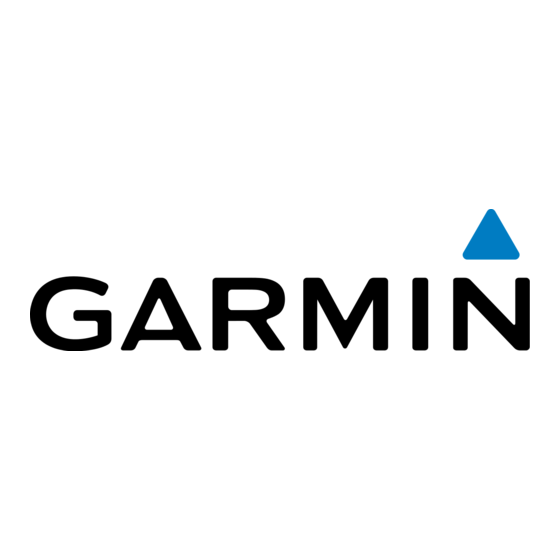Garmin Volvo Penta Panduan Pemilik - Halaman 31
Jelajahi secara online atau unduh pdf Panduan Pemilik untuk GPS Garmin Volvo Penta. Garmin Volvo Penta 38 halaman.

may resolve compatibility issues with older NMEA 0183
autopilots.
Defaults: Restores the NMEA 0183 settings to the original
factory defaults.
Diagnostics: Displays NMEA 0183 diagnostic information.
Configuring NMEA 0183 Output Sentences
You can enable and disable NMEA 0183 output sentences.
1
Select Settings > Communications > NMEA 0183 Setup >
Output Sentences.
2
Select an option.
3
Select one or more NMEA 0183 output sentences, and
select Back.
4
Repeat steps 2 and 3 to enable or disable additional output
sentences.
Setting the Communication Format for Each NMEA 0183
Port
You can configure the communication format for each internal
NMEA 0183 port when connecting your chartplotter to external
NMEA 0183 devices, a computer, or other Garmin devices.
1
Select Settings > Communications > NMEA 0183 Setup >
Port Type.
2
Select an input or output port.
3
Select a format:
• To support the input or output of standard NMEA 0183
data, DSC, and sonar NMEA input support for the DPT,
MTW, and VHW sentences, select NMEA Std..
• To support the input or output of standard NMEA 0183
data for most AIS receivers, select NMEA High Speed.
• To support the input or output of Garmin proprietary data
for interfacing with Garmin software, select Garmin.
4
Repeat steps 2–3 to configure additional input or output
ports.
NMEA 2000 Settings
Select Settings > Communications > NMEA 2000.
Device List: Displays the devices connected to the network.
Label Devices: Changes the labels for available connected
devices.
Garmin Marine Network
The Garmin Marine Network allows you to share data from
Garmin peripheral devices with the chartplotters quickly and
easily. You can connect a chartplotter to a Garmin Marine
Network to receive data from and share data with other Garmin
Marine Network-compatible devices and chartplotters.
EVC Network
Select Settings > Communications > EVC Network, and
select a driveline.
For more information, refer to the Volvo Penta manual.
Features: Shows a list of installed EVC features.
Components: Shows a list of installed hardware components.
Software: Shows a list of software versions for installed EVC
features.
Calibration: Shows a list of installed EVC features that can be
calibrated.
Setting Alarms
Navigation Alarms
Select Settings > Alarms > Navigation.
Arrival: Sets an alarm to sound when you are within a specified
distance or time from a turn or a destination.
Device Configuration
Anchor Drag: Sets an alarm to sound when you exceed a
specified drift distance while anchored.
Off Course: Sets an alarm to sound when you are off course by
a specified distance.
System Alarms
Alarm Clock: Sets an alarm clock.
Device Voltage: Sets an alarm to sound when the battery
reaches a specified low voltage.
GPS Accuracy: Sets an alarm to sound when the GPS location
accuracy falls outside the user-defined value.
Setting the Fuel Alarm
You can set an alarm to sound when the total amount of
remaining onboard fuel reaches the level you specify.
1
Select Settings > Alarms > Fuel.
2
If necessary, select a driveline.
3
Select On.
4
Enter the remaining amount of fuel that triggers the alarm.
5
If necessary, repeat steps 2–4 for all drivelines.
Setting Weather Alarms
Before you can set weather alarms, you must have a
compatible chartplotter connected to a weather device, such as
a GXM™ device, and have a valid weather subscription.
1
Select Settings > Alarms > Weather.
2
Turn on alarms for specific weather events.
My Vessel Settings
NOTE: Some settings and options require additional charts or
hardware.
Select Settings > My Vessel.
For more information, refer to the Volvo Penta manual.
Keel Offset: Offsets the surface reading for the depth of a keel,
making it possible to measure depth from the bottom of the
keel instead of from the transducer location
Temperature Offset: Compensates for the water temperature
reading from a NMEA 0183 water-temperature sensor or a
temperature-capable transducer
Calibrate Water Speed: Calibrates the speed-sensing
transducer or sensor
(page
e-KEY Management: Allows you to manage the electronic keys
(e-KEYs).
Drive Type: The setting should be changed by authorized Volvo
Penta personnel only.
ACP Mode: Sets the ACP protection mode.
Toe Angle: The setting should be changed by authorized Volvo
Penta personnel only.
Speed Factor: Calibrates the displayed boat speed.
PTA Settings: Allows you to enter new maximum limits for the
PTA modes.
Fuel Tank: Sets the fuel tank settings.
Gauge Ranges: Configures the upper and lower limits and the
range of desired standard operation of a gauge.
Setting the Keel Offset
You can enter a keel offset to compensate the surface reading
for the depth of a keel, making it possible to measure depth
from the bottom of the keel instead of from the transducer
location. Enter a positive number to offset for a keel. You can
enter a negative number to compensate for a large vessel that
may draw several feet of water.
(page
25).
(page
26).
26).
25
